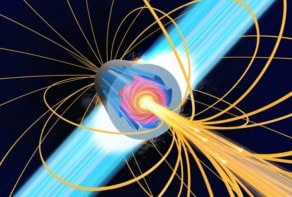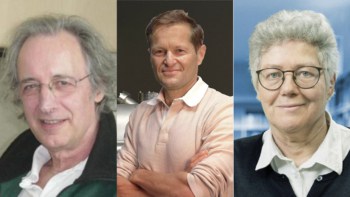Pulses of radiation short enough to probe the nucleus could be generated with existing technology, according to physicists in the US. Alexander Kaplan and Peter Shkolnikov have calculated that a high-power laser could make electrons emit powerful bursts of X-rays or gamma rays just zeptoseconds – 10-21 seconds – long. This ‘lasetron’ could also produce magnetic fields as intense as those found near white dwarf stars (A Kaplan and P Shkolnikov 2002 Phys. Rev. Lett. 88 074801).
The lasetron proposed by Kaplan, of Johns Hopkins University in the US, and Shkolnikov, of the State University of New York at Stony Brook, is based on the principle of synchrotron radiation. Electrons accelerating in a magnetic field continuously emit radiation, and if the electrons are moving in a circle, a stationary observer will see a burst of radiation each time the electrons complete a circuit.
Electronic effects in atoms, such as ionization, typically occur in less than a femtosecond – 10-15 seconds – and these have already been probed by pulses of radiation lasting attoseconds, or 10-18 seconds. But nuclear processes take place about a thousand times faster and existing synchrotrons cannot generate bursts of radiation short enough to study them.
Kaplan and Shkolnikov believe that this problem could be solved by using a super-powerful laser to make electrons circulate extremely quickly. It is well known that electrons circulate in the electromagnetic field of a circularly polarized laser. But according to the pair, existing petawatt lasers – with outputs of 1015 watts – could force electrons to trace out a circle just 0.1 micrometres in radius. This would allow physicists to obtain extremely short pulses of synchrotron radiation.
‘During fission, a nucleus goes through a short-lived transition state when it stretches before breaking into smaller pieces’, Kaplan told PhysicsWeb. ‘This is the kind of process we could observe by scattering zeptosecond pulses off the nucleus’.
The lasetron technique would also generate magnetic fields of up to 106 tesla – a hundred billion times stronger than the magnetic field of Earth. This would allow astrophysicists to study fields as strong as those that exist in space. According to Kaplan, these magnetic fields are within reach. ‘The lasers are available now, although it might take a couple of years to develop the experimental set-up and devices to measure such fields’, he says.
But Kaplan admits that it is likely to be a decade before zeptosecond pulses are achieved. He points out that their calculations are just the first step, and that – currently – nobody even knows how to measure such short bursts.



